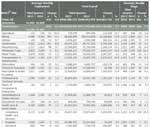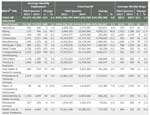
Local Jobs and Payroll in Wyoming in Third Quarter 2014: Nearly Half of New Jobs Are in Construction
The purpose of this article is to illustrate and describe employment and payroll changes between third quarter 2013 and third quarter 2014. These economic changes help gauge the overall strength of Wyoming’s economy and identify the fastest and slowest growing sectors and geographic areas.
 |
Total unemployment insurance (UI) covered payroll increased by $196.9 million (6.3%) in third quarter 2014. Employment rose by 5,219 jobs (1.8%) and average weekly wage increased by $37 (4.4%). In third quarter, employment (1.8% compared to 0.9%), total wages (6.3% compared to 4.0%), and average weekly wage (4.4% compared to 3.0%; see Table 1) all grew faster than their five year averages. Nearly half (2,401, or 46.0%) of the jobs added in third quarter were in the construction sector. In terms of dollars, UI covered payroll represents approximately 91.5% of all wage and salary disbursements and 43.8% of personal income in the state (U.S. Bureau of Economic Analysis, 2014). Analysts have noted that “minerals related employment is one of the key predictors of sales and use tax revenue” in Wyoming (CREG 2010).
Despite the recent growth, overall employment remained approximately 2,950 jobs (1.0%) below its third quarter 2008 level. It appears that the state is getting close to making up all the job losses of 2009 and 2010.
The covered payroll and employment data in this article are tabulated by place of work, in contrast to the labor force estimates which are a measure of employed and unemployed persons by place of residence. Also, the employment data presented in this article represent a count of jobs, not persons. When individuals work more than one job, each job is counted separately. Finally, job growth (or decline) is stated in terms of net change. The Quarterly Turnover Statistics by Industry table presents alternative measures of job gains and losses using the same data sources and calculated to describe the components of change.
 |
Figure 1 shows Wyoming wage & salary employment by covered/non-covered status. Approximately 92% of wage & salary jobs in the state are covered by state unemployment insurance, while 2.6% of jobs are covered by federal unemployment insurance, and 0.9% are covered by unemployment insurance administered by the railroad retirement board. There are several categories of non-covered jobs, and together they account for approximately 5% of wage & salary jobs in the state. Some examples of non-covered employment include elected officials, students working at educational institutions, employees of churches, and workers at small non-profit organizations.

|

|
In third quarter 2014, total payroll increased 6.3%, which was its fastest growth since first quarter 2012 (see Figure 2). The largest contributors to total payroll growth were construction ($48.9 million, or 16.9%) and mining (including oil & gas; $36.2 million, or 6.6%). Table 2 shows that job growth, at 1.8% in both second and third quarters, was much better than growth in the six previous quarters.
Employment and
Wages by County

|
Employment rose in 15 counties, fell in seven counties, and was unchanged in Platte County (see Table 3). Total payroll increased in 21 counties and fell in two.
Campbell County added 1,777 jobs (6.5%) and its total payroll rose by $41.5 million (11.2%). Strong job growth was seen in construction (nearly 700 jobs), mining (including oil & gas; more than 400 jobs), transportation & warehousing (approximately 150 jobs), and wholesale trade (nearly 100 jobs).
Employment rose by 788 jobs (3.7%) in Teton County and total payroll grew by $25.7 million (13.1%). Large job gains were seen in accommodation & food services (approximately 350 jobs), construction (more than 100 jobs), retail trade (approximately 100 jobs), local government, and professional & technical services.
Converse County added 430 jobs (7.1%) and its total payroll rose by $10.8 million (15.7%). The construction sector grew by more than 200 jobs and mining (including oil & gas) grew by approximately 100 jobs. Modest gains were seen in manufacturing and administrative & waste services.
Sheridan County’s employment rose by 390 jobs (3.0%) and its total payroll increased by $7.7 million (6.3%). Large job gains occurred in construction (more than 200 jobs) and smaller gains occurred in local government (including public schools & colleges), accommodation & food services, and manufacturing.
Big Horn County gained 194 jobs (4.5%) and its total payroll increased by $5.2 million (13.0%). Job growth was seen in administrative & waste services, local government (including public schools), manufacturing, other services, and mining.
Sweetwater County lost 542 jobs (-2.2%), but total payroll rose by $6.7 million (2.0%). Employment fell in mining (including oil & gas; approximately 200 jobs), accommodation & food services (approximately 100 jobs), and administrative & waste services (nearly 100 jobs). Smaller job losses were seen in retail trade, real estate & rental & leasing, other services, and manufacturing.
Employment in Sublette County fell by 273 jobs (-5.2%) and its total payroll fell by $1.4 million (-1.8%). Job losses were seen in construction, administrative & waste services, mining (including oil & gas), transportation & warehousing, and wholesale trade.
Fremont County lost 171 jobs (-1.0%) and its total payroll decreased by $0.2 million (-0.1%). Mining employment (including oil & gas) fell by approximately 100 jobs, and smaller job losses were seen in state government, retail trade, health care & social assistance, and accommodation & food services.

|
Natrona County added 835 jobs (2.0%) and its total payroll rose by $44.1 million (8.9%). The largest job gains occurred in mining (including oil & gas; 393 jobs, or 9.7%), construction (291 jobs, or 8.8%), and transportation & warehousing (119 jobs, or 9.7%). Growth was also seen in manufacturing (98 jobs, or 5.7%), retail trade (72 jobs, or 1.5%), and health care & social assistance (70 jobs, or 1.2%). Employment fell in other services (-165 jobs, or -8.8%) and accommodation & food services (-108 jobs, or -2.5%).

|
Laramie County’s employment increased by 633 jobs (1.4%) and its total payroll grew by $14.3 million (3.0%). Sizeable job gains were seen in transportation & warehousing (495 jobs, or 19.5%), accommodation & food services (286 jobs, or 6.5%), and mining (including oil & gas; 211 jobs, or 76.7%). Employment fell in retail trade (-253 jobs, or -4.4%), construction (-230 jobs, or -6.1%), and other services (-106 jobs, or -7.5%).
Statewide Employment
and Wages by Industry

|
At the statewide level, almost half of the new jobs (46%) were found in the construction sector (see Table 4). Strong growth was also seen in mining (including oil & gas), transportation & warehousing, local government (including public schools, colleges, & hospitals), accommodation & food services, and manufacturing. Employment fell in other services, retail trade, and federal government.
Construction added 2,401 jobs (10.2%) and its total payroll rose by $48.9 million (16.9%). Employment fell slightly in construction of buildings, but increased rapidly in heavy & civil engineering construction (approximately 1,800 jobs) and specialty trade contractors (more than 600 jobs). It appears that much of the growth was concentrated in oil & gas pipeline and related structures construction.
Mining gained 817 jobs (3.1%) and its total payroll increased by $36.2 million (6.6%). Employment remained stable in oil & gas extraction and mining (except oil & gas). Support activities for mining, which includes oil & gas well drilling and oil & gas field services added more than 800 jobs.
Employment rose by 753 jobs (7.6%) in transportation & warehousing and its total payroll grew by $13.4 million (11.2%). Job losses in air transportation (approximately 150 jobs) were more than offset by job gains in warehousing & storage (approximately 350 jobs), support activities for transportation (approximately 200 jobs), and truck transportation (nearly 200 jobs). Smaller job gains were seen in couriers & messengers, transit & ground passenger transportation, and pipeline transportation.
Local government added 615 jobs (1.5%) and its total payroll rose by $17.6 million (4.2%). Education (including public school districts and community colleges) gained 733 jobs (4.1%) and hospitals gained 109 jobs (1.6%). Employment fell in public administration (including cities, towns, & counties).
Accommodation & food services gained 414 jobs (1.1%) and its total payroll increased by $9.7 million (5.8%). Most of the job gains occurred in accommodation (more than 300 jobs) while employment in food services & drinking places increased only modestly.
Manufacturing employment grew by 336 jobs (3.5%) and its total payroll grew by $10.8 million (8.0%). Large job gains were seen in petroleum & coal products manufacturing (more than 100 jobs), fabricated metal product manufacturing (approximately 150 jobs), and computer & electronic product manufacturing (more than 100 jobs).
Other services lost 463 jobs (-5.5%) and its total payroll fell by $5.2 million (-6.9%). Employment fell by nearly 300 jobs in repair & maintenance, nearly 100 jobs in personal & laundry services, and nearly 100 jobs in membership associations & organizations.
Retail trade employment fell by 173 jobs (-0.6%), but its total payroll increased by $5.0 million (2.4%). Job losses in nonstore retailers, general merchandise stores, and gasoline stations were partially offset by job gains in motor vehicle & parts dealers, miscellaneous store retailers, and health & personal care stores.
Federal government lost 95 jobs (-1.2%), but its total payroll increased by $6.7 million (5.6%). Employment fell in administration of environmental quality programs.
In summary, Wyoming’s economy continued to grow in the third quarter, with the construction sector accounting for nearly half of all new jobs. Large job gains were also seen in mining (including oil & gas), transportation & warehousing, local government (including public schools, colleges, & hospitals), accommodation & food services, and manufacturing. While employment grew in about two-thirds of Wyoming’s counties, most of the job gains occurred in Campbell, Natrona, Teton, Laramie, and Converse counties.
References
Consensus Revenue Estimating Group (CREG; 2010, October) Wyoming state government revenue forecast fiscal year 2011-fiscal year 2016. Retrieved February 17, 2011 from http://eadiv.state.wy.us/creg/GreenCREG_Oct10.pdf
U.S. Bureau of Economic Analysis. (2014, June 17). SA04 State income and employment summary. Retrieved June 17, 2014, from http://www.bea.gov/iTable/iTable.cfm?ReqID=70&step=1&isuri=1&acrdn=4